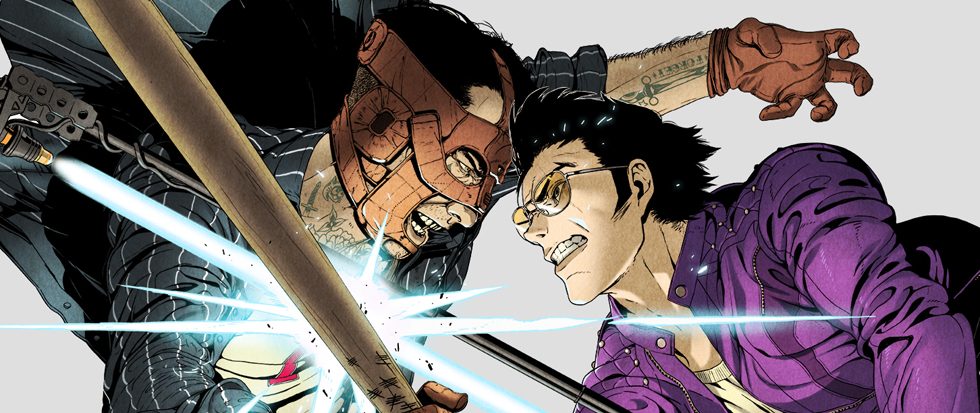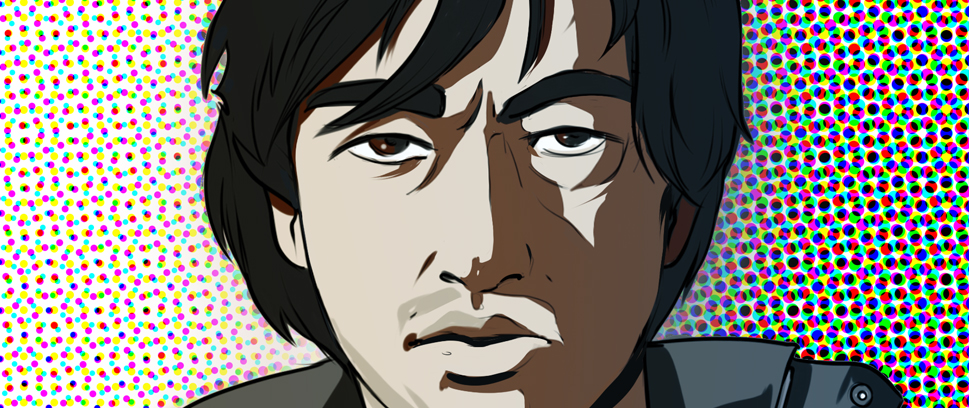
Suda-51 Strikes Again
Whether it’s Killer7, No More Heroes 1 & 2, the recent Let It Die or the many other titles that oscillate between post-modern thought experiments and hyper-aestheticized violent outbursts, few people can remain a centrist when it comes to Suda-51 and Grasshopper Manufacture’s works. His upcoming “Nindie” (aka Nintendo switch indie game) Travis Strikes Again: No More Heroes probably won’t be shattering any preconceptions on his work either way, but at least the demo did a wonderful job of roasting PAX East on the show floor.
TSA, which is still quite early in development and knowing how Suda’s games go could shape-shift into several different forms, currently plays as a top down brawler featuring series mainstay Travis Touchdown and his new best frienemy Badman. Two players join up as this pair and are sucked into the Death Drive Mark 2 console to smash digital spawns and gab with cryptic quipping ghosts. It’s an action game that pulls from the history of the genre, from Streets of Rage through Hotline Miami, though when I asked Suda at PAX East what his particular influences were he said he was mostly trying to get back to the games of his childhood, like Smash TV. That pop-violence skewering classic clearly shows on all of Suda’s works, and in TSA specifically as it demands the player commit massive, oversaturated brutality while wickedly dissecting the medium at the same time.
A Suda-51 game is a curious thing, an antithesis of Nintendo’s long-standing family friendly image. I asked Suda how he managed to keep tricking the big N into publishing his games and he laughed, saying that the original No More Heroes wasn’t originally developed for the Wii. However they did have a relationship with Nintendo, and the more Suda thought about publishing his game where you save by taking a dump and charge your laser sword by flailing the Wiimote around like a shake-weight on one of the biggest and most family-friendly consoles in gaming history, he couldn’t turn down the opportunity. He enjoyed existing as an outlier to Nintendo’s general image, and in doing so other mature games got the opportunity to shine on Nintendo’s platforms.
Thinking about Grasshopper as a black sheep on the Wii, I asked Suda if he felt his work was on the fringe of gaming culture in general, and if he felt his work was received differently in the west versus Japan. He thought about it for a bit, and replied that he never really saw himself as counter-culture until recently, mostly likely because he kept getting asked how it felt to look a little from the outside in. In Japan he and his team recently celebrated the 20th anniversary of The Silver Case, one of his and Grasshopper’s first games, and they had a sold out audience of over 200 people. His co-producer Kuma-san showed me a picture of the evening that resembled a sold-out hardcore gig in a large church basement, full of cheering and sweaty punks. Suda’s reputation as a shitkicker to the industry comes mostly from the western media and player base, though he’s fine with that as well.
The titular Travis Touchdown exists as a rejoinder as well, a cracked mirror held up to superfans and hipsters alike, both suave and a smarmy nerd. Suda said he knows Travis inside and out at this point, and it was natural to return to him for another game. Suda is writing and directing this one himself, which he hasn’t done for a little while. I asked how much Travis was a reflection of Suda himself against his opinions on gamer culture, he smiled and said Travis is about 51% Suda. The developer does have a singular voice though, which shines through all his work even in translation. One wonders if the fourth wall ever existed for him, as he regularly converses with the player and has his characters comment on the absurdity of life within and outside of a video game. The TSA demo is a conversation between its showing at GDC and PAX, saying that the gamers demanded more content and stimulation so they added more for PAX and will probably have even more for “that European show.” That Suda voice just comes naturally to him he says, it is his default mode of expression at this point.
I asked Suda what it meant to be working on TSA as an “indie.” It’s a much smaller team he said, and everyone had to have multiple roles—from development through PR. But with that smaller team comes a sense of freedom, which is interesting to think about since it’s not clear that Grasshopper has ever been dictated to. But for this project the entire team is regularly meeting face-to-face, collaborating on problems and ideas rather than operating in silos, letting them hit the ground running with concepts for a quicker turnaround time. Though as shown in the demo, the “indie” scene at large can be tight-knight—Travis is wearing a Hyper Light Drifter shirt and Suda says they hope to cross-pollinate with other indies and Nintendo games, and even says he’s happy to allow that all his games exist in the same small universe, so that references to his work may pop up in other ways. He’s also hoping they can reach a new generation of gamers, and judging by the reactions from the young scrappers on his own team, he feels confident that they’re on the right track.
Really though, I wanted to know what sick thrill Suda got from making players jerk-off their controllers. He said he really enjoyed making players feel bashful, to think about what they’re doing in service of the game. Grasshopper Manufacture wants to subvert videogames, to bend them to Suda-51’s will, but they don’t want to bring them crashing to the ground, and Travis Strikes Again looks to continue this willowy tradition.




